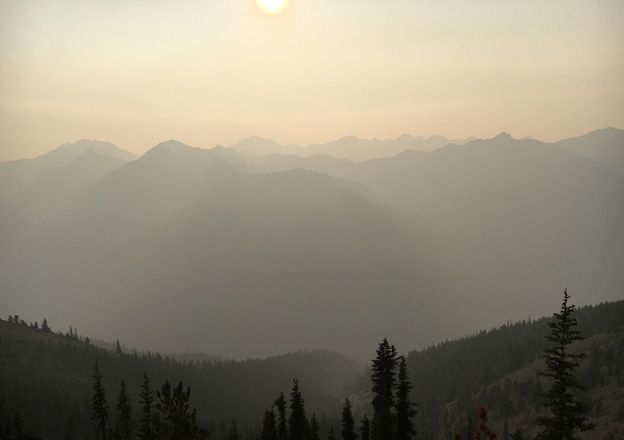Smoke produced by wildfires, including forest fires, can spread widely and cause public health risks to air quality. Climate change is causing fires to become more severe and long lasting on average which has made it especially important to understand and avoid smoke and pollutants in our atmosphere. Yet, because of the many factors that affect the way that smoke moves, it is hard to know when smoke concentrations will worsen and become dangerous.
Forecasts for smoke in the pacific northwest in the summer of 2020 severely underestimated how long atmospheric conditions would cause the wildfire smoke to blanket the area. The atmospheric models failed to correctly track how smoke would behave, and therefore were not able to predict that the thick layer of smoke would not dissipate until days later. Situations like this indicate that the ongoing unpredictability of our smoke models requires serious consideration in order to prevent health and economic problems.
Properties of Wildfire Smoke
Smoke can travel thousands of miles from the original source of the fire. The concentrated heat of wildfires drives the smoke high into the atmosphere until it cools and starts to descend. When the smoke moves to ground level, it becomes diluted and spreads over a larger area.

The terrain of the surrounding area can affect how smoke moves and concentrates. It can trap smoke in valleys and basins, making pollution in cities like Mexico City much more dangerous for their residents. Daily cycles of heating and cooling and temperature inversions can also have an effect; heat can direct the airflow of smoke and pollutants.
Smoke is a serious health concern because it is composed of a mixture of pollutants and water vapor. Particle pollution, a general term for the mixture of suspended solid and liquid droplets, is the main component of wildfire smoke. All air contains some amount of particle pollution, but wildfire can create concentrations of particles that are visible as smoke or “smog”. Smoke can have cardiovascular and respiratory-related effects, especially when concentrations reach high levels.
Predicting Smoke and Air Quality
Smoke raises the level of particle pollution in the air, and can cause air quality concerns for surrounding residents. Air quality, like other weather factors, can change quickly and unpredictably. Therefore, predicting exactly when and where smoke from wildfires will affect local air quality is a difficult task. Factors such as wind, weather systems, and local terrain can cause different outcomes for air quality.
Here are some of the challenges that accurate smoke predictions face:
- It is a hard task to calculate the weather, terrain, climate, wind and other factors necessary to make accurate smoke predictions.
- Accurate smoke forecasts are only released about once a day. This makes it particularly hard to track the behavior of wildfires which can change and expand rapidly throughout a single day.
- There are not yet enough smoke monitors to pass on enough data to make accurate predictions, particularly at high elevations and in rural communities. Using satellite images is difficult because clouds can obscure smoke.
- Smoke and weather can each affect the other, such as instances where temperature inversions trap smoke close to the ground. This creates further complications for atmospheric models.
Much of our current problem predicting smoke patterns is a result of a lack of investment in the technology and computational power needed for accurate predictions. With rising awareness of the issues of smoke generated by out of control wildfires, investment in improving the predictability of smoke patterns will likely increase.
Tracking Air Quality
Despite the current challenges tracking this issue, there are several good tools that can provide information on smoke concentrations in America. The U.S. Air Quality Index (AQI) is a widely used measurement tool for smoke concentration in America. It runs from 0 to 500; the higher the value, the greater concentration of harmful pollution in the air and danger of harmful health effects. Here are descriptions of the standard levels of the air quality index; they include six color-coded levels that range from good to hazardous values of air quality pollutants. Scales like these factor into account which groups of people may be more sensitive to air pollution than the general population.
Tools like the Fire and Smoke Map track fires and measure air quality across the country. Concentrations of smoke can change frequently so it is important to check for updates on future air quality predictions.
